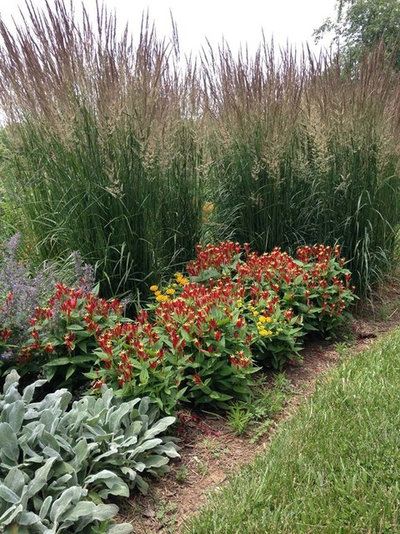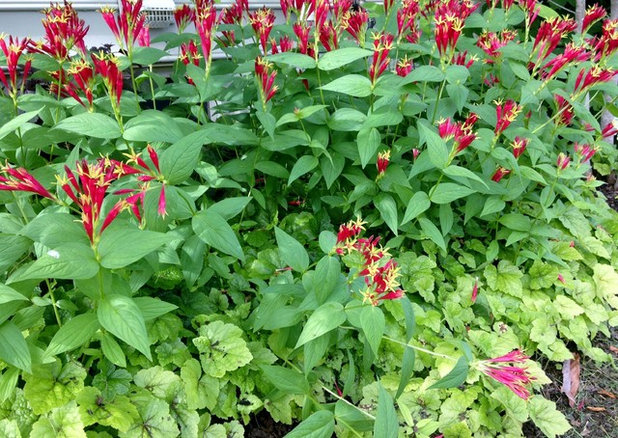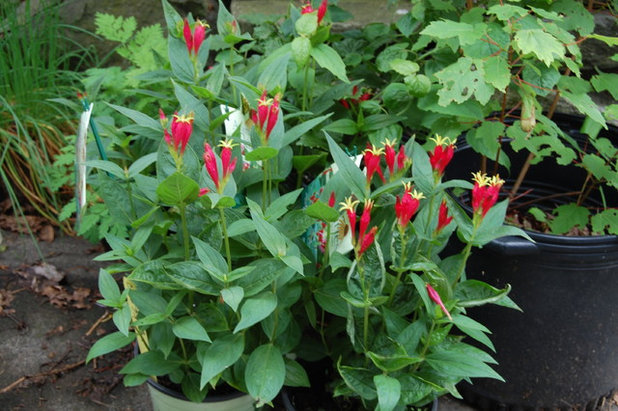Many hummingbird plants grow best in full sun or partly sunny sites. Some early spring bloomers will grow under trees, but there aren’t many choices for later in the season, after the shade canopy fills out. Indian pink (
Spigelia marilandica) is an exception; it prefers growing in dappled shade, producing bright crimson and yellow tubular flowers in mid to late spring. These brightly colored tubular flowers are ideally suited for hummingbirds. In fact, Indian pink is listed among the top 10 native plants for hummingbirds by Operation RubyThroat, a nonprofit initiative studying the ruby-throated hummingbird.

Earth Design, Inc.
When I first saw this plant in bloom in 2008, I said, “Hot dog!” Not only was I fascinated by its striking appearance, but I thought it looked kind of like a hot dog with ketchup and mustard. Since that time, I have been working this plant into designs where I need a late spring bloomer in open shade. The plant continues to look good after blooming, with its glossy leaves forming an attractive ground cover in a woodland or other partly shady site.
In 2008 it was uncommon in nurseries, but supplies seem to be increasing, and it is starting to show up in retail nurseries, as well as online and by mail order. Winter is a great time to think about next year’s garden. If you’re planning a hummingbird garden, Indian pink needs to be on the planting list.
Botanical name: Spigelia marilandicaCommon names: Indian pink, woodland pinkroot, wormgrass
Origin: Native to woodland edges and shaded woods of the southeastern U.S., from Maryland south to Florida and west to Texas
Where it will grow: Hardy to -30 degrees Fahrenheit (USDA zones 4 to 9; find your zone)
Water requirement: Prefers moist soils and does not tolerate droughty conditions
Light requirement: Grows best in dappled shade but will grow in full shade as well; can be grown in full sun if supplied with adequate moisture (too much sun can bleach the edges of the leaves)
Mature size: Grows in upright clumps, 1 foot to 2 feet tall and about 1 foot wide
Caution: All parts of the plant are considered poisonous.

Tom Mannion Landscape Design, Inc.
Benefits and tolerances: The red and yellow tubular flowers are very attractive to hummingbirds; it is an ideal plant for a moist, shady garden.
Seasonal interest: Indian pinks bloom in June, when the tips of the crimson tubular flower buds open up to reveal bright yellow five-pointed stars. Deadheading will increase the blooming period and can lead to a second flush of flowers in the fall; after the flowers are gone, the plant acts as a dense ground cover, which is an asset in shady spots.
When to plant: Indian pinks are slow to establish and will take two to three years to mature; planting should be done by the end of July to give the plants time to settle in.
This photo shows Spigelia on a sunny site; a setting like this will work as long as there is sufficient moisture. Other plants used here include feather reed grass (
Calamagrostis ‘Karl Forester’), catmint (
Nepeta sp) and lamb’s ears (
Stachys sp).
 Distinguishing traits.
Distinguishing traits. The coloration of the flower is quite interesting. The crimson and yellow flowers really set this plant apart. The outer part of the petals is an intense crimson, and the inner lining is bright yellow. The yellow color is revealed when the bud opens.
After the blooms are gone, the broadly lance-shaped, glossy, opposite leaves will provide interesting texture through the rest of the season.

Lush Life Landscapes
How to use it. It is a great choice to use under trees and taller shrubs, as it grows best in moist, partial shade. In my garden it is growing happily under a large rhododendron, with exposure to morning sun. The plants are slow to come up in spring, so they do not interfere with early spring bloomers and other woodland ephemerals. They can be combined with early native bloomers, like Virginia bluebells (
Mertensia virginiana), Dutchman’s breeches (
Dicentra cuccularia) or spring beauties (
Claytonia virginica). On sites that are not too moist, they can be used with spring-blooming bulbs. There the late foliage will cover the fading leaves from the bulbs.
While a single plant will stand out in bloom, Indian Pinks are more effective and will do a better job of attracting hummingbirds in large masses. An individual flower is self-fertile and can produce seeds by itself; cross pollination by hummingbirds leads to better seed production and more plants in the long term.
This photo shows foamflower (
Tiarella cordifolia), which fills out in the early spring, and Indian pinks, which take over as the foamflower’s blooms fade in June. After a hard frost, the evergreen foamflower will continue to fill the bed.
 Planting notes.
Planting notes. Though not common in the trade, this plant is being seen more often in retail nurseries and native-plant nurseries. It is also available from several mail-order nurseries. It does not transplant well, so it should be sited with care in the garden.
Plants in Spigelia’s family (
Loganiaceae) contain toxic alkaloids. Indian pinks contain spigeleine, which has anthelmintic (worm-expelling) properties and was used by Native Americans for that purpose. All parts of the plant are considered poisonous.
Deer browsing is not supposed to be an issue with this plant. Despite this, I have had deer (or perhaps a groundhog) eat the flowers off of some of my more exposed plants.
Propagating Spigelia
can be tricky. Its seeds ripen about a month after they are pollinated (typically July) and are best planted when fresh. Left alone the ripe seedpods will burst open and the seeds will be dispersed some distance, helping to spread the colony. Propagation by tip cuttings and divisions has proven successful. Propagation by root cuttings is tricky.





